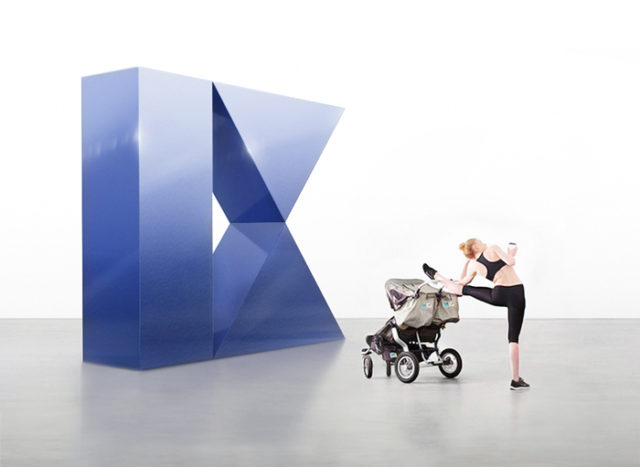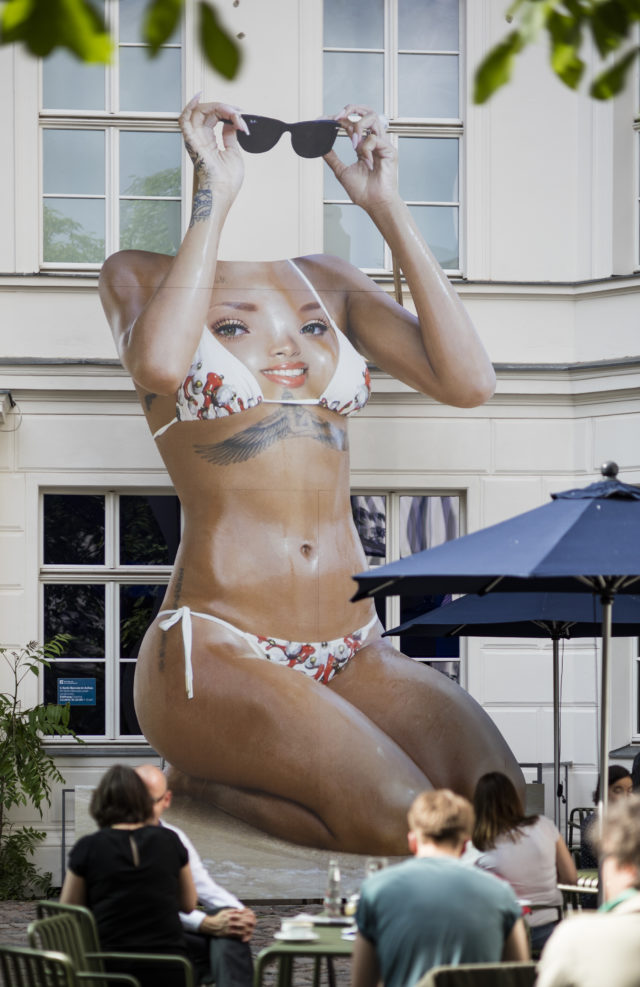
Courtesy Berlin Biennale
Since the last Berlin Biennale, Europe has undergone a currency and debt crisis, watched far right political entities grow from obscure clusters of nutjobs into massive populist movements, dealt, badly, with the millions of people fleeing conflicts in the Middle East and North Africa, and been subjected to terrifying and brutal acts of terrorism by all manner of extremists.
In all of these crises, Berlin, the capital of the EU’s richest and most politically powerful country has played a central and keynote-determining role.
I can thus think of no better way, given the circumstances, to reinforce the popular perception that contemporary art has nothing to say about the world that surrounds it than by hiring the NYC-based fashion bloggers DIS to curate the ninth edition of the Berlin Biennale. I have rarely seen such a profound case of not giving the people what they want, of so many heads so far up so many assholes.
Just walk away, Berlin. Go have a strong drink. Read a good mystery novel. Take too much MDMA and pee your slacks. Sit in an empty room and cry. Do anything but waste 26 Euros on the Berlin Biennale.
I am not arguing that every work of art must pay keen attention to (nor certainly attempt to resolve) world problems. But I cannot see the value of artworks that exist in and speak solely to a snarky, self-affirming vacuum either, as do almost all of the works I saw at the BB. There is so much avoidance of current problems on offer here that one could reasonably see the entire project as an act of retreat, even denial. It’s as if the world is too much for DIS and their assembled artists, so they’ve all gone back to the rec room to play video games.

Juan Sebastián Peláez, Installation view, “Ewaipanoma (Rihanna)”, 2016, Mixed media
Courtesy Juan Sebastián Peláez, Photo: Timo Ohler
Apart from the usual Biennale-normal stunt/Pop works (Juan Sebastián Peláez’s giant headless statue of Rihanna, Babak Radboy’s silly poster project asking “Why should Fascists have all the fun?” Anne de Vries’s video installation mashing EDM festival crowds with demonic animated versions of same, and Nik Kosmas‘s gym-based workouts), most of the work is meant to look like a hybrid of an elaborate science fair project and a corporate presentation booth.
And that is the point: that art and culture are now just another form of capitalism, one wholly mediated by and accessed through technology. Well, yeah. Is there someone alive who does not know this?
The smug tone of the Biennale, the “we are going to teach you about the new world” pushy cleverness-for-cleverness’s-sake actually works against whatever there might be available to learn or digest or simply enjoy. One quickly turns off after the third of fourth time one has been spoken to like an idiot.
A perfect example of this shutting-off effect is Lizzie Fitch and Ryan Trecartin draining video installation As Yet Untitled Sculptural Theater, which is essentially a re-hashing of their early works, a “greatest hits”. Given a prominent placing it hardly deserves in the Akademie der Kunst, the video is the usual Fitch/Trecartin mad clumping together of narratives, characters, and noise that once seemed so urgent and now just looks like somebody’s experiments with their new editing suite posted on Youtube. It’s insulting for DIS to present such stale-dated works as if one were bringing them to the hinterlands.
I would argue that even including Fitch and Trecartin, is throwback to the first wave of digital technology enthusiasm that promised us that technology will take care of the future. Having lived through that time, I not only know those promises never happened but can not help but be reminded by how much it sounds like the neo-liberal mantra “let the free market fix it”.

Anna Uddenberg, Installation view, Journey of Self Discovery, 2016, Mixed media, Courtesy Anna Uddenberg Photo: Timo Ohler
Equally frustrating are Anna Uddenburg’s sculptures of anime-style, hyper-sexualized women, one of which is depicted attempting to take a selfie of her butt (an assie?). Look, I’m all for a bit of porny gender play, but these works are puerile. They look like giant versions of the kind of ornament ashtrays you find in biker shops. And no amount of post-Third Wave gender theory highjacking can make them what they are not. There is no investigation of gender in these works, only an affirming of ancient, male-generated fixations – in particular, the woman as self-pleasuring spectacle. Again, one feels that one is being “taught” that feminism acknowledges women’s sexuality, but this is Berlin, a world capital of female-centred and created pornography and also one of the world’s most trans-inclusive spaces, a place where gender is itself regarded as a question, not a reliable position. Show this work in North Carolina and then we can talk.
It’s not that I don’t get that we live in a world of relentless noise and commodified post-you-name-it sexualities. Plus ca change. It’s not that I don’t get the selling of an Instagram feed as a discourse, or the positing of the poly-platforming of images and information as the new currency; it’s that I don’t buy any of these breathlessly unveiled revelations – “the present in drag”, as DIS has named it – as particularly revelatory. Had the Biennale attempted to apply any of the above discourses to the alarming real-world problems facing Europe, maybe the conversation would not feel so rote, so museum-standard (so goddamn NYC hipster – there, I said it). All the Biennale succeeds in conveying is a sad-making nostalgia for the bright and shiny promises made by new media in the 1990s. I mean, really: films projected onto sculptures, flat screen TVs everywhere, CGI, online corporations as art projects, co-opting multi-national brands as an act of intervention? Good heavens, next you’ll be telling me about some mad new world that includes file sharing!
The real pity here is that underneath all this anthem-braying (walking through the various halls, I kept hearing the pop song “Kids In America” playing over and over in my head, as everything was just so buoyant and moneyed and Caucasian) lie two excellent works that deserve better, more considered placements: Cecile B. Evans’s What The Heart Wants and Christopher Kulendran Thomas’s New Eelam.

Cécile B. Evans, installation view, “What the Heart Wants”, 2016, HD-Video, HD video, color, sound, 40‘; water, wooden platform, Courtesy Cécile B. Evans; Galerie Emanuel Layr, Vienna; Barbara Seiler, Zurich, Photo: Timo Ohler
Evans short film presents a future that is predictably safe and orderly and predictably creepy at the same time, and leaves the viewer to decide if we find the science fictions dystopic or utopic. In Evans’s possible future, robots care for humans and the economy is run by AI. The robots look sad and the humans look bored. Or, the robots live outside of our human emotional spectrum and the humans are content. You decide. The ambivalence of Evan’s film is refreshing, especially since most of the work on offer mistakes shrugging indifference for nuance and perspective. Watching What The Heart Wants in the context of the Biennale felt like reading a thoughtful book in a room covered in graffiti tags. This work will go places.

Christopher Kulendran Thomas, Installation view, New Eelam, 2016, Mixed media, Developed in collaboration with Annika Kuhlmann, Film Production Klein and West, Mark Reynolds, Design Manuel Bürger, Jan Gieseking, Production Design Marcelo Alves, Biosphere Matteo Greco, Creative Director Annika Kuhlmann, Courtesy Christopher Kulendran Thomas; New Galerie, Paris, Photo: Timo Ohler
Similarly, Thomas’s controversial installation New Eelam takes the culture of the sharing economy to the next level. Designed to look and sound like a slick real estate development proposal, the installation allows the viewer to join a subscription-driven community of people attempting to live in a more open and borderless world; one that includes practical resources such as access to housing around the world and to the fancy new art placed in that housing. Ultimately, New Eelam proposes a new form of movable citizenship with accompanying rental properties.
Now, this proposal is full of obvious problems. The first being that, at present, only the rich will ever be able to use New Eelam’s services. But what if the company grows? What if it becomes as omnipresent (and thus affordable) as other shared economy ventures?
Putting “New Eelam” up in Germany during the weeks prior to and following the UK’s referendum on EU membership, is damned good luck or good timing or both. And Germany never shuts up about the “refugee problem” (which is indeed a problem, but hardly, for first world Germans, one of domestic resources), so anything on the subject of housing access feels deeply relevant. Thomas’s proposed movable citizenship – fraught as it is – struck me as at least an attempt to play with (and potentially re-design) how people construct a concept of “home”.
(The controversy, by the way, stems from Thomas’s use of the word “Eelam”, the Tamil separatist movement’s name for their aspirational homeland. In 2009, the Sri Lankan military massacred tens of thousands of Tamils, separatist fighters and civilians, and thus ended any foreseeable independence for the Tamil population. Thomas has been accused of appropriating and misusing a word that has come to signify terrible loss and pain, and I am not without sympathy for that argument. However, I am not Tamil, and I will not further a possible act of appropriation by appropriating more of the dialogue here.)
So, two strong works in a very big yet very flimsy assembly. You don’t always get what you pay for.
As mentioned above, DIS has called their Biennale “the present in drag”. Well, I am gay, I’ve done drag, and, sorry kids, but what you got here ain’t fucking drag. Drag is an act of defiance. The DIS Biennale is an act of passive compliance; compliance with the engagement strategies of global capital, brand and fashion currencies, future and present constructions of money moving, and all corporatized technology’s blinking, twinkly toys.
The Berlin Biennale is about as “drag” as Davos. A little bit of the messy, disruptive energy of drag would be heartily welcome at this dull, status-quo affirming trip to The Gap. #everythinginbusinesscasual


Comments on this entry are closed.
{ 1 trackback }